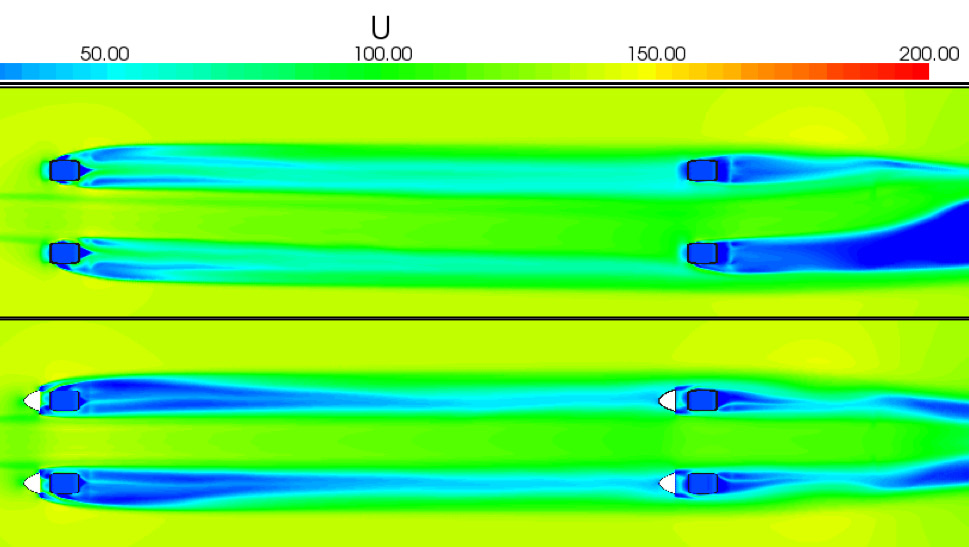left: In simulations Ohio State's Cary Bork conducted at the Ohio Supercomputer Center, airflow under the Buckeye Bullet traveling at 300 mph without wind deflectors installed in front of the wheel wells (A) is compared with the airflow under the vehicle with wind deflectors installed (B).
A team of engineering students at The Ohio State University’s (OSU) Center for Automotive Research (CAR) recently began running aerodynamics simulations, one of the first steps in the complex process of designing, building and racing the fourth iteration of their record-breaking, alternative-fuel streamliner.
“The third-generation electric land speed record vehicle to be designed and built by OSU students, the Buckeye Bullet 3, will be an entirely new car designed and built from the ground up,” noted Giorgio Rizzoni, Ph.D., professor of mechanical and aerospace engineering and director of CAR. “Driven by two custom-made electric motors designed and developed by Venturi, and powered by prismatic A123 batteries, the goal of the new vehicle will be to surpass all previous electric vehicle records.”
In 2004, the team achieved distinction at the Bonneville Salt Flats in Utah, by setting the U.S. electric land-speed record at just over 314 mph with the original Buckeye Bullet, a nickel-metal hydride battery-powered vehicle. Several years later, the team returned with the Buckeye Bullet 2, a new vehicle powered by hydrogen fuel cells, and set the international land speed record for that class at nearly 303 mph. The team then replaced the power source with a new generation of lithium-ion batteries and last year set an international electric vehicle record in partnership with Venturi Automobiles and A123 Systems at just over 307 mph.
This spring, the team, again in partnership with Venturi and A123 Systems, began the development process for a completely re-engineered vehicle designed to break the 400-mph mark. In consideration of that blistering speed, one of the first critical aspects the team had to consider was aerodynamic design.
“What sets the new design apart from the previous vehicles is that at these higher speeds it is possible to produce shock waves under the vehicle,” said Cary Bork, chief engineer for the team and an OSU graduate student. “Minimizing or eliminating these shock waves is critical to ensuring the safety and stability of the vehicle.”
For both versions of the Buckeye Bullet 2, student engineers ran aerodynamics simulations on Ohio Supercomputer Center systems to compliment studies of physical models tested in wind tunnels. However, the current team quickly found that wind tunnels with a 'rolling-road' component required to test land-bound vehicles at the target speeds do not exist. Rizzoni and Bork, therefore, ran even more extensive simulations at OSC, giving shape to the lean, new streamliner.
After more than a year of preparation, the team hopes to unveil yet another record-setting Buckeye Bullet in 2012.
--
Project lead: Giorgio Rizzoni, The Ohio State University
Research title: Buckeye Bullet 3 aerodynamic simulation
Funding sources: The Ohio State University, Venturi Automotive, A123 Systems, TotalSim LLC
Web sites: www.buckeyebullet.com/ & http://car.osu.edu/node/46
